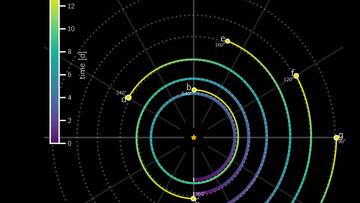An exceptional solar system discovered: its planets have resonant orbits
A six-planet solar system around the star HD110067, a near sun-like star roughly one hundred light years away, has stunned scientists by its rarity.

A solar system that has not undergone major changes since its formation is very rare, but there is a star a little more than one hundred light years from Earth that is just so. Orbited by six planets, its secrets are beginning to be revealed by science. The star HD110067, in the northern constellation of Coma Berenices, was already known, but its exoplanets were not. A team led by Spanish astrophysicist Rafael Luque, from the University of Chicago (USA), published its discoveries about this special system in the journal Nature, which offers an unusual vision of planetary formation and evolution.
In other words, there are many stars that have planets orbiting around them, but the exoplanets that orbit HD110067 do so synchronously. Hence its rarity. This phenomenon is known as orbital resonance, which indicates that the system has not undergone major changes in its millions upon millions of years of life. Researchers believe the finding may help better understand planetary formation.
This type of resonance occurs at the beginning of the formation of a system, but in the first million years some chaotic process usually occurs, for example a very massive planet, an encounter with a nearby star or a gigantic impact can upset that careful balance. In this case, its six planets maintain that resonance, following a precise rhythm and tracing a unique pattern for each pair, which represents an exceptional case.
In fact, in 99% of cases, the planets are redistributed in “somewhat random” orbits, losing resonance, explains Enric Pallé, from the Institute of Astrophysics of the Canary Islands (IAC) and signatory of the study. The system in question is “extraordinary”, according to Pallé, because it has preserved its configuration since its formation, which shows that it has not undergone major changes since its inception, estimated to be about one billion years ago.
In addition, the six planets transit in front of their star, from Earth’s perspective, something very unusual, which together with the relative brightness of its sun, slightly smaller than our own, has turned this system into a small laboratory or test bench, both astrophysicists agree. These three characteristics will allow scientists to reconstruct the history of this system, going back in time to even establish what the disk of dust and gas from which it formed was like, something that is not possible with planets that have moved from their orbit, indicates Pallé.
It has not been ruled out that there is water on the planets
Other characteristics that have been determined are the mass, size and radius of each one, as well as that they are located too close to the star to be in the so-called habitable zone, all six are orbitting withing a similar distance of that of Mercury to our Sun. However, it has not been ruled out that there may be water present on them. The orbits are estimated to range between about nine days for the innermost planet and about 54 days for the outermost one, and the six exoplanets are subneptunes, that is, their radii are between that of the Earth and that of Neptune.
While waiting for the James Webb space telescope to obtain new data on its atmospheres, it is known that they are extensive and “probably composed mainly of hydrogen and perhaps something else,” which, according to Luque, “we don’t know what it is or in what quantity.”





